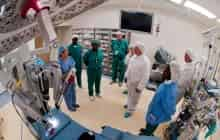
Improvements in technique and surgical instrumentation allow today’s surgeons to insert prosthetic knee joints using shorter skin cuts with less surgical trauma, resulting in fewer days spent in the hospital. These most recent trends in knee replacement surgery focus on improved rehabilitation and pain management to accelerate post-surgery recovery. Employing new surgical techniques to reduce the size of the incision and damage to soft tissue has been the primary advance toward this goal. These techniques are known as MIS or Minimally Invasive Surgery. However, this shouldn’t be confused with keyhole surgery and this procedure is more precisely referred to as a “Reduced Incision Approach.”
Minimally invasive knee replacement accomplishes everything that a traditional knee replacement does via a 4- to 6-inch incision as opposed to an 8- to 10-inch incision.
Although the moniker MIS may suggest a less intense procedure, all knee replacement procedures involve the negotiation through or around muscles and tendons, the cutting of bone from the knee and the attachment of a replacement implant to the bone. MIS does involve a much smaller incision than in conventional knee replacement.
The general idea of knee replacement is the same today as it was decades ago, but we now have better implants, improved instruments, computer navigation technology and robotics, and vastly improved anesthesia techniques that have radically changed joint replacement surgery.
Despite these improvements, there are still some risks with MIS. In experienced hands, these procedures have superb short term outcomes, with faster recovery, less pain, and shorter down time. But not all surgeons can deliver these results.
With limited visibility afforded to the surgeon, MIS techniques do carry a risk of increased complications including sub-optimal device placement. Optimally placed implants trump a fast recovery time when it comes to long-term success. So, if your surgeon has particular interest, training, and experience in MIS knee replacement, then you should discuss the benefits of this technique with him. Otherwise it may be best to stick with traditional techniques, despite the longer recovery time.
You should research the issue, ask questions, speak with your surgeon, carefully weigh your options, before making a decision. In the years to come, implants, surgeons, and techniques will continue to change, delivering more benefits (and associated risk), more promise, and better ultimate outcomes to knee replacement patients.
For more in depth information about MIS for Knee Replacement see Minimially Invasive Knee Replacement Approaches & Procedures
image credit: misschristi1972
Filed Under: Knee ReplacementKnee Replacement, Resurfacing, Revision




